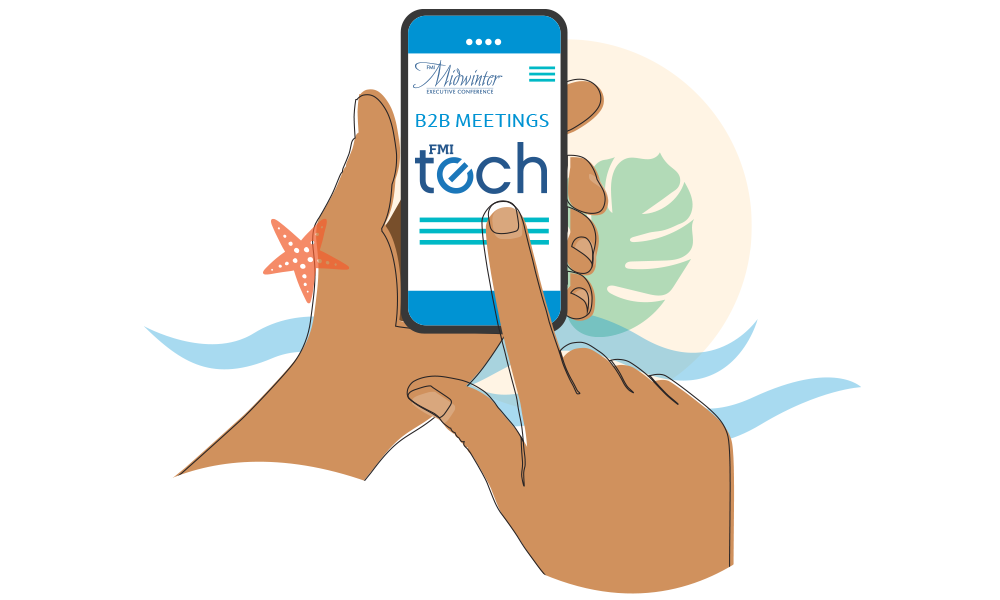By Steve Markenson, Director, Research & Insights, FMI
 While the competition and presentations at FMITech at Midwinter enlightened attendees to the latest and greatest our industry has to offer in technological advancements, the Lunch and Insights presentation by Laurie Demeritt of The Hartman Group served to ground us in the importance of what the food industry has to offer.
While the competition and presentations at FMITech at Midwinter enlightened attendees to the latest and greatest our industry has to offer in technological advancements, the Lunch and Insights presentation by Laurie Demeritt of The Hartman Group served to ground us in the importance of what the food industry has to offer.
Techtonic Changes
We have seen the way we “do food” – grow, manufacture, meal plan, source, and prepare – make giant leaps forward in the high-tech direction in recent years and the pace of “food tech” innovation is only accelerating.
While consumers have accepted and even embraced many scientific and technological innovations in their food lives, they have remained guarded when it comes to what they put in their own and their family’s bodies.
Evolving Consumer Sentiment
There is a mounting sense of urgency around the challenges facing the food system – sustainability, food security, ethics, health and well-being – that is helping soften consumer resistance to science and technology around food. In the past
three years, consumer sentiment regarding scientific and technological innovations to make food more sustainable, address climate change and make food more healthy have moved in a positive direction. Consumers are also more open to modern industrial
systems for farming and raising animals. A majority of consumers now believe that science and technology can help solve global issues and this sentiment is growing rapidly.
It's About Taste
But, while many of these food tech companies are leading with a focus on better for the planet and better for me, taste is still the biggest driver in the shopper’s path to purchase. That is not to say that better for the planet and better for me
are not important, but without taste there is little appeal.
Youth Movement
The Hartman Group research also explored a range of new food technologies and discovered some generational divides. Young consumers, Gen Z and millennials, are much more open to new approaches such as nutrient fortification using nanotechnology, biomass
fermentation, cultured meat, precision fermentation and cell-based seafood.
Industry Considerations
As Laurie concluded her presentation, she left us with five key things for the food industry to consider as we promote these innovations:
- Demonstrate that the ends justify the means.
- Empower and allow for informed choices.
- Create value at the intersection of Good for We and Good for Me.
- Enhance connections to the human side of food.
- Ensure new technology provides consumers value not just flash.
What’s Really Important?
The Hartman Group’s report Food & Technology takes a deeper dive into all of this and so much more. But Laurie’s guidance to the audience to not get caught up in the excitement of the latest technology and to remember what food means to
the consumer is what really caught my attention. As she reminded us, beyond all the excitement accompanying these innovations, ultimately food is about nourishing ourselves, nurturing and showing love.


 Industry Topics address your specific area of expertise with resources, reports, events and more.
Industry Topics address your specific area of expertise with resources, reports, events and more.
 Our Research covers consumer behavior and retail operation benchmarks so you can make informed business decisions.
Our Research covers consumer behavior and retail operation benchmarks so you can make informed business decisions.
 Events and Education including online and in-person help you advance your food retail career.
Events and Education including online and in-person help you advance your food retail career.
 Food Safety training, resources and guidance that help you create a company food safety culture.
Food Safety training, resources and guidance that help you create a company food safety culture.
 Government Affairs work — federal and state — on the latest food industry policy, regulatory and legislative issues.
Government Affairs work — federal and state — on the latest food industry policy, regulatory and legislative issues.
 Get Involved. From industry awards to newsletters and committees, these resources help you take advantage of your membership.
Get Involved. From industry awards to newsletters and committees, these resources help you take advantage of your membership.
 Best practices, guidance documents, infographics, signage and more for the food industry on the COVID-19 pandemic.
Best practices, guidance documents, infographics, signage and more for the food industry on the COVID-19 pandemic.
